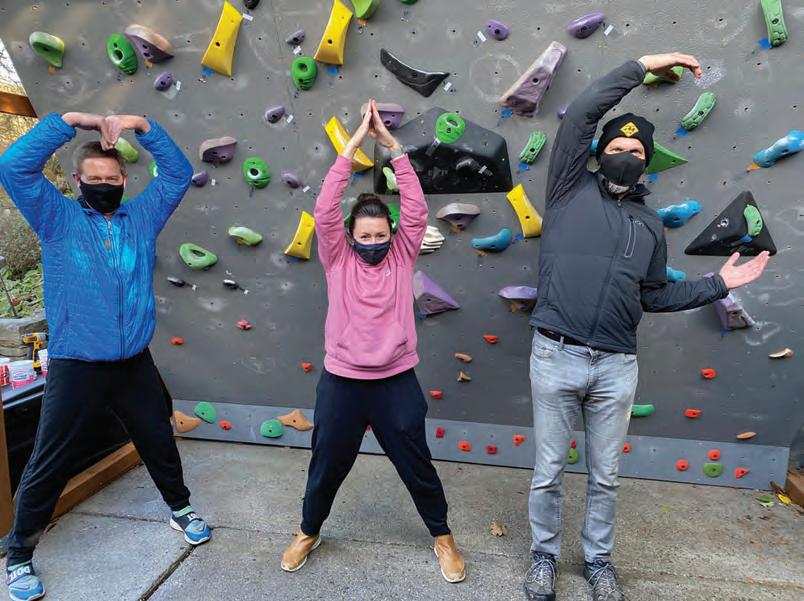
4 minute read
Climbing Gym Finds Fans of All Ages
Three friends appreciate time together in updated space
As more MAC members began returning to the club this fall, fans of the Climbing Gym had an additional reason to be excited —a significant upgrade to its walls (as reported in the August 2020 Winged M.) The updated climbing wall replaced an older-style textured fiberglass structure. It had served MAC well over the years, but was considered outdated by competitive climbers training for national and international arenas. Two feet taller and constructed according to the latest designs by Entre-Prises USA, the new wall provides a surface conducive to modern route-setting.
The first words that came to Ellewyn Swafford’s mind in describing the new features were “forward-thinking.” A member of the MAC Climbing Team, Swafford reminisced, “I kind of miss the old wall because that’s what I started climbing on eight years ago, but the new wall is definitely better for training.” The Climbing Team resumed practices in October with masks on, proper social distancing and reduced numbers of participants in the space at any one time.
Forward-thinking adults also found a new routine in the space. With flexible work schedules now more commonplace, three friends decided to make a once-aweek midday visit a part of their routine. John Raaf, Avery Cook and Matt Swafford are the self-described “JAM Squad” who began meeting at lunch on Wednesdays. Cook, a longtime climber, was previously a member coach for the MAC Climbing Team and is currently a member of the national governing board of USA Climbing. Her son, Atlas (2), recently started climbing at MAC. Raaf began climbing in college and has two sons, Julian (15) and Miles (11), on the Climbing Team. Swafford took up climbing more recently after his daughter, Ellewyn, joined the team eight years ago. While his first visits were primarily to support her, he’s now adopted climbing as a favorite past time and a focus for physical training.
The first thing Cook appreciated about the new wall was that the modern façade can be better used for emphasizing footwork and technique. It allows coaches and setters to position holds in ways that force the climber to focus on a specific movement. “Avery, I always appreciate watching your climbing technique. Your feet are so precise and quiet,” Swafford pointed out on one route. Climbers with strong footwork are more balanced and conserve energy. Having quiet feet is a clear display of controlling the body through your feet. It’s one thing to be told to focus on quiet feet using efficient placement, but it’s quite another to actually slow down, look where you are placing your foot, place it and then look for the next move in the sequence. It sounds simple but is more difficult in practice, especially when the body is trying to do a number of other things simultaneously. It helps to observe other climbers and accumulate a mental catalog of moves.
“The technique training potential is fantastic. This is what I needed as a coach, especially for teaching the little beginners,” said Cook when asked what she thought of the renovation. “I’m actually going to miss that old wall surface,” Raaf replied. He had a habit of finding small bumps and edges others didn’t notice.
Punctuated by important safety checks on the harnesses, the JAM Squad conversation wanders from parenting to books to Netflix recommendations. After so much time under stay-at-home constraints, it was particularly beneficial to have some in-person (albeit masked and socially distanced) connection with friends.
“Okay, who’s ready to get on the wall?” asked Cook. Swafford tied into the rope and scanned a new route. “The smooth new wall means precision is even more important now, huh?” he said before scrambling his way up a route and just missing the last hold. “Looks like I have a new route to project.”
The mix of mental focus, puzzling out the best sequence, proper movement technique and physical strength make climbing a fun and challenging sport. Each climber moves a little differently, making it even more interesting. Projecting a route is the process of working on it until being able to get to the top, efficiently.
It had been a while since they climbed as a group. “Wait. Who climbs next?” Swafford asked. Cook helpfully reminds us, “it’s climb, belay, pick” (i.e., choose your next route). This simple saying was their way of managing roles as a group of three where each route only requires two active participants. “I’m going to amp it up a bit and climb the purple route,” said Raaf as he was tying into the rope. It was a pretty difficult route with purple holds that look like organ pipes emerging from the wall at angles and rotated in ways that required a mix of strength, precision and efficiency to finish. “Climbing with a mask does take some getting used to, but it’s good to be back,” Raaf said. They all agreed that it’s better to participate-with-precautions than to not climb at all. Frankly, after the first few climbs wearing a mask, they didn’t give it much more thought or discussion. It became incorporated into the regular safety routine for climbing and that was it. The enjoyment of climbing, conversation and connection was more important than the changes to prior routines.




